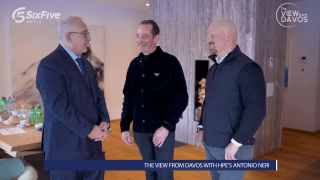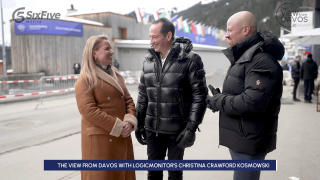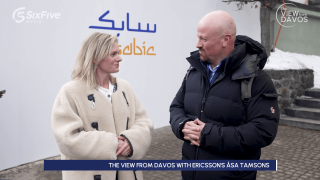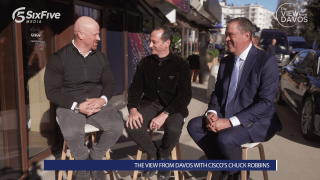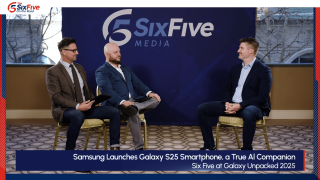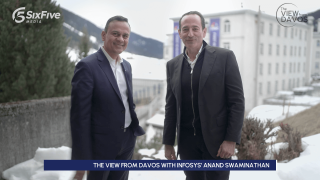The Six Five On The Road finished CES 2023 strong! Patrick Moorhead & Daniel Newman talk with Nakul Duggal, Senior Vice President and General Manager, Automotive at Qualcomm. Their conversation covers:
- Qualcomm’s collaboration with Sony for their concept vehicle
- Bringing CRM to vehicles with the help of Salesforce
- Snapdragon Ride Flex SoC role in software-defined vehicles at CES 2023
Be sure to subscribe to The Six Five Webcast so you never miss an episode.
You can watch the full video here:
You can listen to the conversation here:
Disclaimer: The Six Five On the Road is for information and entertainment purposes only. Over the course of this webcast, we may talk about companies that are publicly traded, and we may even reference that fact and their equity share price, but please do not take anything that we say as a recommendation about what you should do with your investment dollars. We are not investment advisors, and we do not ask that you treat us as such.
Transcript:
Patrick Moorhead: Hi, this is Pat Moorhead. We are live in Las Vegas at CES 2023. The Six Five is on the road in the Qualcomm Automotive Experience Center. It is awesome. It is day two or day three. I’m kind of forgetting. It’s a blur, Daniel, but we are here and having fun.
Daniel Newman: Part of the benefit of being press analyst is you come like a week before the show actually starts, and you hear everything in advance and then you still have to be here when the show’s going on. And now it’s Saturday, and what a start to the year, though. I mean it was a little bit of downtime and it was like you stood straight up, you got on a plane and we were back in action. But a great week. Great to be here in the Qualcomm booth.
Patrick Moorhead: Yeah, we’re in the West Hall and in the Qualcomm experience center and as you can see, we’ve got this incredible concept car behind us, but we’re going to get that later. First thing I want to do though is introduce our guests. Nakul, how are you? Back on the Six Five?
Nakul Duggal: Great to see you both. Happy New Year.
Patrick Moorhead: Yeah, you too. You too. This is my favorite hall, because this is where the action is.
Nakul Duggal: And hopefully your favorite booth too.
Patrick Moorhead: I’ll tell you what, I was only allowed in to look through the windows. This is the first time I’ve actually been in here, but is it pretty awesome here.
Nakul Duggal: Fantastic. Good to see you both.
Daniel Newman: Yeah, it looks great. And yes, the West Hall, it meets all the things that I think about on a daily basis and when semiconductors meet automobiles, my ears perk up, my eyes perk up, my spirits go up. But your spirits, Nakul, should be up. I mean look, we’ve had parts of this conversation, but I want to start somewhere we have talked about.
2022 was a big year for you, for the business. In a single quarter, I believe, you more than doubled your design pipeline. I think 30 billion was the most recent number. Talk a little bit about … for our audience, what’s driving all that momentum and then kind of what’s the Qualcomm momentum going to look like going into 2023?
Nakul Duggal: So I think at Analyst Day or at Investor Day in September of last year, we outlined our overall strategy. It is something that we have been working on for quite some time, and the approach that we have taken is to understand the trajectory of the auto industry, what amount of transformation is going on, what are the key pieces that will have to get transformed? What are some of the pieces that perhaps may take a bit longer? And the bets that we have made are based upon our forecast, our intelligence, our assumptions.
And the strategy is not, I don’t even really call it a semiconductor strategy. It really is a strategy around building a roadmap to become a partner to the auto industry. It’s not a short term, what happens next year or the year after that. Everything that we are working on, all conversations, serious conversations that we are having today are for designs that will be in the ’27 and beyond timeframe. So everything between now and then, it’s all known, understood, there is an execution piece to it.
The part that we have started to spend a lot of time on is what does the digital chassis actually mean? What all can we include? What can we host? Where can we bring partners in? And how do automakers embrace that? Those are the things that I think we will see a lot more change and discussion on in the next, let’s say, 12 months or so.
Patrick Moorhead: Yeah, it has been quite a ride. I remember, gosh, it was three, four years ago. I knew you were heavy duty into telematics. You were getting into the dash and entertainment and then your team really surprised me when they said, “Hey, do you want to take a little ride with us? We have a first demo.” And here we are three, four years later, we’ve got this super cool concept car back here. And it’s funny, I love concept cars. I see a lot of them. Many times they’re quite frankly, a little bit of a yawner, a little bit of disappointment. But I have to tell you, I got in this thing and I want to drive this thing off the lot. Are you getting into the car business, getting into … are you moving up the food chain or is this just something entirely different?
Nakul Duggal: We’ve been thinking about getting into the car business. We are not-
Daniel Newman: I’m so glad you were kidding.
Nakul Duggal: We are not getting into the car business. Look, I think the concept car is important for us because we actually feel very passionately about the automotive business and about what the potential of the car is. We built this platform, it’s using our commercial grade silicon software. It’s going to be a chassis that we will continuously reimagine. It has 24 speakers, it has 17 cameras. It has a fantastic audio experience. The look and feel, the displays. This is our SDB development platform. Everything that we will do with customers, we will have an internal twin on top of it, which we will deploy.
It’s fantastic for the employees, it’s fantastic for the engineers because this is something that we couldn’t get to develop on. But very importantly, we onboard now our partners on this platform. So if you want to … we were working with Salesforce four months ago, first time we ever spoke to them. And they’re integrated now into this platform because of the way that the chassis is deployed. So we feel like you have to be able to have a way to [inaudible 00:05:20] , have a way to actually understand for yourself what it means to be able to build this, but then also explain it to your partners, to the customers. So-
Patrick Moorhead: This is actually quite different from just a typical concept car, now that you talk, you said you have production grade silicon in here, as opposed to futuristic or duct tape something together. But does the employee of the month get to drive this for Qualcomm?
Daniel Newman: Not a serious question.
Nakul Duggal: The car can actually be driven. It’s an EV. It can actually be driven.
Patrick Moorhead: Seriously?
Nakul Duggal: Yes.
Patrick Moorhead: It actually-
Nakul Duggal: The car can actually be driven. Obviously in a controlled area, so yeah.
Daniel Newman: One more question on the car, because this is the stuff everyone loves anyways at the shows, everyone wants to see the gadgets, touch the gadgets. I love the suicide doors. Why are you designing nicer looking cars than most of the auto-
Patrick Moorhead: No, seriously, that is my first impression. I look at wheels and-
Daniel Newman: I would drive. You know me, I have pretty discriminating taste.
Nakul Duggal: We have to make it fun, right? I mean you have to enjoy what you are bringing to life. And so yeah, I think we’re taking it seriously.
Daniel Newman: Seriously. So software defined vehicles been a bit of a buzz here, hearing a lot of chatter talk, and of course, there’s the semi companies, software companies are all playing a big role. Some of the automotive companies have kind of made a run at trying to do the software. I think we’ve kind of decided that largely it hasn’t gone great, and that’s why companies like yours have been more and more brought in. Talk a little bit about the trend and Qualcomm’s role in the software defined vehicle, Nakul.
Nakul Duggal: So couple of different ways to come at it from. I think the first is that as the auto industry starts to embrace more software, what you have to keep in mind is that there is a lot of legacy implementation of a variety of different functions that were developed on different platforms, smaller scale platforms, developed with very specific use case or function specific application development.
And most of these had a safety-centric mindset to them. So certification was important. Making sure that all the checks and balances were there were important. As you start to change the foundation of software from a microcontroller-based architecture to something that is much more capable, much more powerful, you obviously have the fragmentation problem. There are so many different things that you have to now define.
We have spent a lot of time thinking about how do you look at the journey of the development of a car, all the way from how do you design it to how will you support it, and split it up into three parts. One is what are the pieces of innovation in software that you actually have to keep thinking about continuously. And more importantly, what should you actually not further, what you should actually not continue to push forward? And we’ve reached the conclusion that safety software platforms are going to be a thing that every automaker is going to have to need. So we’ve invested in platform software with partners, such that the silicon that we built is silicon plus a tremendous amount of platform software.
We harden that, we made that robust and we made sure that that remains consistent. We have one or two flavors of those configurations, and we made sure that remains very consistent as we go across automakers. Also it remains consistent as we go across generations. So there is a tremendous amount of reusability.
The layer on top then is about consumer grid applications and safety applications and how do they coexist. With consumer grid applications, the whole idea is to not have to reinvent the wheel, because there’s a lot of capability available, let’s just figure out how to reuse it. Safety applications is where there is still going to be fragmentation because that is an area where everybody’s going to have kind of their own view to it.
The third piece is moving to cloud-based development. How do you bring the cloud into the picture? How do you create a digital twin? How do you test in the cloud? And that is another new thing for the industry that obviously a lot of folks are spending time on in terms of figuring out how to implement. So with these types of things, what is important for us is, look, we are in the business of selling chips and software and launching programs, right? That’s business number one. Everything else that you see is really a means to an end. And the strategy is to make sure that everything that we built is SDV ready. The definition of STV will vary for customers, but the idea is think about defragmenting-
Patrick Moorhead: What’s SDV ready?
Nakul Duggal: Software-defined vehicle ready.
Patrick Moorhead: Got it. I got it. By the way, I really like where we’ve come as an industry. It really is a maturation of … and you had talked about it years back where we started, and where we started was black boxes-
Daniel Newman: 2,400 for almost everybody, just a second.
Patrick Moorhead: A rethinking of things that didn’t need to be rethought, particularly on the consumer side, and then even on the safety side, black box with no way to really differentiate or add value, and adding value on either the tier one or the OEM side. Everybody kind of wants a different thing to slot in. Now, a framework is typically harder to come up with and it takes longer times, there’s more touch points, but at the end, if I look at the smartphone market, which I think is a really good example, but then you put on the safety element that you don’t have in smartphones, on the automotive, I think we’re in a really good place. And it’s not to say that we won’t morph and shift, but I think as an industry we really are poised for growth.
Nakul Duggal: There is a big difference between a consumer platform and a car platform. Car platform is regulated, it has a very different set of expectations. The life cycle is very different. You can’t make mistakes that you perhaps couldn’t get away with. So the thought process, the philosophy, the risk that you can take, start from a very different point of view. And then also the ecosystem is much more complex, much more diverse than, say, in the smartphone space, you have small number of companies can have an opinion as to how things should evolve.
Patrick Moorhead: Right, so I think we’re in a good place.
Nakul Duggal: Yeah.
Patrick Moorhead: So CES 2023, big announcements. You made some really big announcements at your Automotive Financial Analyst Day in New York that we met with you at, and did a Six Five video. Flex was one of the big statements you made there. And backdropping Qualcomm telematics and connectivity in auto for decades, coming into dash, and I would say dominating the modern dashboard. But now in this element of automation, ADAS, and self-driving, Flex gives the ability to have one platform but have different levels of performance and capabilities.
Nakul Duggal: So we teased Flex at Investor Day. See, the thing to keep in mind now is that everything that we are going to be talking about is something that we will actually productize in 18 to 24 months. These are not concepts, these are not ideas. This is not tied to something that might get used in the future. So it’s very real. It’s much part of our roadmap. What Flex is doing is, the first message we’re sending is that the silicon that we are developing is safety silicon. So we are an automotive silicon supplier. We are going to be building high performance silicon that will be safety grade.
What that means is we actually, at some point in time, don’t care what workload you run on it. You can run infotainment, you can run the cockpit, you can run ADAS, you can run them concurrently. What we are showcasing at CES this year is exactly that. So we have our commercial grade silicon that will run cockpit and driver assistance concurrently, and you can run it going forward on any of the silicon that we will have. So almost disconnecting the workloads from the underlying silicon. And the silicon is designed for concurrencies, for the right power consumption, for the performance.
This is the trend that we see moving forward. Some automakers might decide, “No, we want to keep these domains very separate.” Absolutely you can do that. It’s the same piece of silicon. Those that want to combine it or do it at different tiers of the vehicle, that that’s possible as well. So it’s one more step into the chassis strategy and been very well received.
Daniel Newman: Yeah, the whole modularity was always something that I was impressed by, because as we discussed, the black box kind of was the thing. And these automotive companies are going to have to start differentiating on the technological. Of course, there’s going to be the ADAS, but a lot of that’s going to be regulated. It’s going to be standardized. That experience is going to be somewhat similar from vehicle to vehicle. But things like the infotainment systems and the telematics, there’s going to have to be a uniqueness that each car maker’s going to need to bolt the software on top of the systems that you’re delivering them, to be able to offer something different. Because in the future, what used to make cars different, a lot of things about engines, they’re going to be electric. It’s just super-
Nakul Duggal: One of the most important things for an automaker today is to have a conversation around, “Hey, this is the budget that we have. This is the experience that we want to create. This is our timeline. Do you have something and how real is it, when can we get started, and what controls do we have?” This approach that we have taken and now showcasing allows customers to be able to know exactly what is possible. That makes a huge difference.
Daniel Newman: Qualcomm’s pretty good at licensing. You could talk to one of those OEMs, Nakul, and have licenses of this baby.
Nakul Duggal: I will connect with you offline-
Daniel Newman: I was mostly kidding.
Patrick Moorhead: Nakul, you talked a little bit more about Flex. What other announcements did you make?
Nakul Duggal: So we made a momentum announcement around Snapdragon Ride. We have a lot more tier ones that have not started to take that silicon. We made announcements with the Salesforce. We are bringing CRM to the edge. That’s a really interesting opportunity because it is taking the brick and mortar customer information in the cloud, connecting it to the real time life cycle of the car. Lots of opportunities there. We announced, obviously, our concept vehicle and everything that’s possible here.
And then of course we made the Snapdragon on Satellite announcement, which I think is really a fantastic opportunity. Not just for phones, but also for cars.
Patrick Moorhead: Exactly, yeah.
Nakul Duggal: So you will hear more from us on that one.
Patrick Moorhead: Up in the mountains, you’re stuck in the snow, you might want to send a message out there-
Nakul Duggal: No, it’s a great service for a platform that is a car-
Patrick Moorhead: Yeah, I know this company that’s been powering OnStar for years. You might know something about that.
Nakul Duggal: I think all of our customers are super interested in learning more about that.
Daniel Newman: I actually had a chance to talk to Durga on Tuesday about it. That was a great announcement. And Nakul, congratulations on all the announcements.
Nakul Duggal: Thank you.
Daniel Newman: I know you’ve got to run onto your next thing, busy day here, Saturday at CES 2023. But always appreciate how gracious you are with your time. The world’s excited about what you’re doing.
Nakul Duggal: Thank you very much.
Daniel Newman: And we look forward to continuing to document and track it and provide our analysis of what’s going on.
Nakul Duggal: Great to see you both. Happy new year.
Patrick Moorhead: Thanks. Good to see you.
Daniel Newman: All right everybody, you heard it here, CS 2023 at the Qualcomm booth talking with Nakul Duggal about what’s going to be the future of Qualcomm’s automotive strategy. And it was a great conversation. For everyone, if you like what you heard, hit that subscribe button. Join us for all of the episodes here at CES 2023, and all the interviews that Pat and I do all year long, and our Friday show. We love you for it. But for now, for this one, you got to say goodbye. So we’ll see y’all later. Thanks for tuning in.


